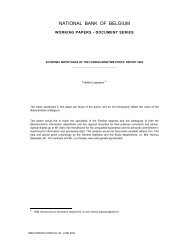A multi-factor model for the valuation and risk management of ...
A multi-factor model for the valuation and risk management of ...
A multi-factor model for the valuation and risk management of ...
You also want an ePaper? Increase the reach of your titles
YUMPU automatically turns print PDFs into web optimized ePapers that Google loves.
future months it does not mature (i.e. an earnings approach). Moreover, instead <strong>of</strong> only investing<br />
in <strong>the</strong> bonds that are included in <strong>the</strong> portfolio, we instead assume that <strong>the</strong> amount to be invested<br />
in each bond is spread out in equal amounts over all intermediary maturities. More explicitly, when<br />
<strong>for</strong> example 50% <strong>of</strong> outst<strong>and</strong>ing deposits is invested in <strong>the</strong> 5-year zero coupon bond, e¤ectively<br />
0.833% <strong>of</strong> deposits is invested in <strong>the</strong> 1-month zero coupon bond, 0.833% <strong>of</strong> deposits in <strong>the</strong> 2-month<br />
zero coupon bond, ..., 0.833% in <strong>the</strong> 60-month zero coupon bond. Of course, such a spreading <strong>of</strong><br />
<strong>the</strong> investment implies that <strong>the</strong> resulting duration is half as large, relative to <strong>the</strong> case where no<br />
spreading <strong>of</strong> investments occurs.<br />
For both setups, we assume that <strong>the</strong> bank ei<strong>the</strong>r wants to minimize <strong>the</strong> volatility <strong>of</strong> <strong>the</strong> spread<br />
between <strong>the</strong> replicating portfolio return <strong>and</strong> <strong>the</strong> deposit rate, or that it wants to maximize <strong>the</strong><br />
Sharpe ratio between <strong>the</strong> replicating portfolio return <strong>and</strong> <strong>the</strong> deposit rate. Finally, notice that we<br />
assume away volume e¤ects (deposit withdrawals <strong>and</strong> growth) <strong>for</strong> convenience.<br />
In a …rst step, a large number <strong>of</strong> plausible monthly yield curve scenarios <strong>for</strong> <strong>the</strong> next 60 months<br />
is generated, based on our estimated three-<strong>factor</strong> yield curve <strong>model</strong> under <strong>the</strong> <strong>risk</strong>y probability<br />
measure. For each yield curve scenario, <strong>the</strong> implied term structure <strong>of</strong> yields <strong>and</strong> one month log<br />
holding period returns, r(t + 1; ), can be derived. One month log holding period returns can be<br />
derived from <strong>the</strong> log yield curve dynamics in each scenario, as follows:<br />
r(t + 1; ) = y(t; ) ( 1)(y(t + 1; 1) y(t; )) (26)<br />
where r(t + 1; ) denotes <strong>the</strong> log return <strong>of</strong> holding <strong>the</strong> -month bond between months t <strong>and</strong> t + 1.<br />
In a second step <strong>and</strong> <strong>for</strong> each <strong>of</strong> <strong>the</strong> scenarios, we <strong>the</strong>n optimize <strong>the</strong> margin or spread between<br />
<strong>the</strong> replicating portfolio holding period return on <strong>the</strong> one h<strong>and</strong> <strong>and</strong> <strong>the</strong> respective deposit rate<br />
return on <strong>the</strong> o<strong>the</strong>r h<strong>and</strong>, resulting in a vector <strong>of</strong> optimal portfolio weights. The optimal portfolio<br />
weights, averaged over <strong>the</strong> scenario runs, are <strong>the</strong>n used to back out an implied duration, using <strong>the</strong><br />
fact that <strong>the</strong> duration <strong>of</strong> a discount bond is equal to its remaining time to maturity.<br />
Table 12: Duration estimates across banks, based on a dynamic replicating portfolio<br />
approach<br />
Holding period Monthly reinvestment (returns) Hold to maturity (yields)<br />
Optimization Maximize Minimize Maximize Minimize<br />
criterion Sharpe ratio st<strong>and</strong>ard deviation Sharpe ratio st<strong>and</strong>ard deviation<br />
Bank no. 1 2.320 0.218 4.530 3.547<br />
Bank no. 2 2.520 0.220 4.546 3.592<br />
Bank no. 3 2.336 0.220 4.545 3.583<br />
Bank no. 4 2.262 0.214 4.470 3.435<br />
Bank no. 5 4.163 0.206 4.392 3.243<br />
Bank no. 6 2.603 0.215 4.493 3.482<br />
Bank no. 7 2.826 0.208 4.409 3.293<br />
Bank no. 8 3.139 0.205 4.367 3.200<br />
Average across banks 2.771 0.213 4.469 3.422<br />
Table entries re‡ect duration estimates in years, averaged across 100 scenario runs (i.e. 100 simulated 5-year yield<br />
curve dynamics, with <strong>the</strong> replicating portfolio optimization per<strong>for</strong>med <strong>for</strong> each bank <strong>and</strong> <strong>for</strong> each simulated yield<br />
curve scenario). See main text <strong>for</strong> <strong>the</strong> main assumptions behind <strong>the</strong> dynamic replicating portfolio exercises per<strong>for</strong>med<br />
here.<br />
Table 12 entries represent duration estimates <strong>for</strong> all banks in our sample <strong>and</strong> averaged across <strong>the</strong><br />
100 scenario runs. Table 12 shows that discretionary choices about <strong>the</strong> optimization criterion or<br />
<strong>the</strong> holding period are not innocuous. When per<strong>for</strong>ming <strong>the</strong> optimization with holding period<br />
returns, we …nd that <strong>the</strong> estimated duration averaged across <strong>the</strong> banks is 2.8 years when <strong>the</strong><br />
Sharpe ratio <strong>of</strong> <strong>the</strong> margin is optimized, while only 0.2 years when <strong>the</strong> st<strong>and</strong>ard deviation <strong>of</strong> <strong>the</strong><br />
margin is minimized. When per<strong>for</strong>ming <strong>the</strong> optimization with yields, we …nd that <strong>the</strong> estimated<br />
duration averaged across <strong>the</strong> banks is 4.5 years when <strong>the</strong> Sharpe ratio <strong>of</strong> <strong>the</strong> margin is optimized,<br />
20
















